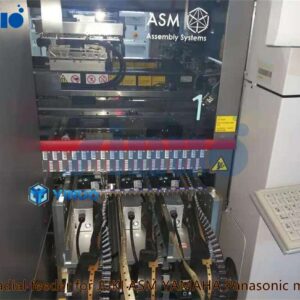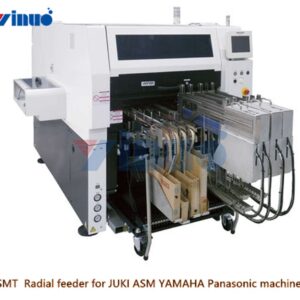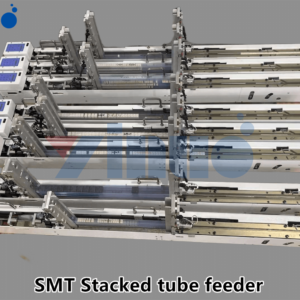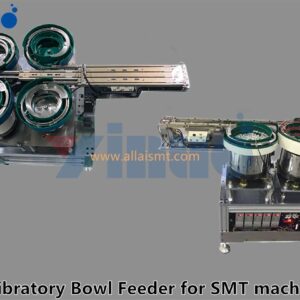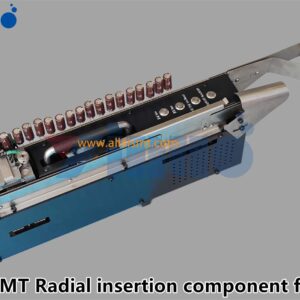
Radial Feeders
Overview of SMT Radial Feeders
Radial feeders are used to handle radial-leaded components, such as:
- Radial capacitors (e.g., electrolytic capacitors).
- Radial resistors.
- LEDs.
- Diodes.
- Other through-hole components with radial lead configurations.
These feeders are essential for Through-Hole Technology (THT) or hybrid assembly lines, where both SMT and THT components are used.
Key Features of SMT Radial Feeders for JUKI, ASM, YAMAHA, and Panasonic Machines
- Radial Component Feeding:
- Designed to handle radial-leaded components supplied in tape-and-reel or ammo pack packaging.
- Ensures smooth and continuous feeding of components to the pick-and-place machine.
- Lead Cutting and Forming:
- The feeder cuts the leads of radial components to the desired length.
- Lead forming ensures the component fits perfectly into the PCB’s through-holes.
- High-Speed Operation:
- Compatible with high-speed pick-and-place machines from JUKI, ASM, YAMAHA, and Panasonic.
- Ensures a steady supply of components to avoid production delays.
- Precision Placement:
- Ensures accurate alignment and positioning of components for the pick-and-place head.
- Reduces errors and improves assembly quality.
- Compatibility:
- Designed to integrate seamlessly with pick-and-place machines from:
- JUKI: Known for their flexible and high-speed SMT machines.
- ASM: Advanced SMT solutions for high-volume production.
- YAMAHA: Reliable and versatile SMT machines.
- Panasonic: High-speed modular placement machines.
- Can handle a wide range of radial component sizes and lead pitches.
- Designed to integrate seamlessly with pick-and-place machines from:
- Durable and Robust Design:
- Built with robust materials to withstand the demands of high-volume production environments.
- Designed for long-term reliability and minimal maintenance.
- Customizable Settings:
- Adjustable to handle components of various sizes, shapes, and lead configurations.
- Compatible with different lead pitches and component dimensions.
Applications of SMT Radial Feeders
- Through-Hole Technology (THT):
- Used in assembly lines where through-hole components are required for mechanical strength or specific electrical properties.
- Hybrid Assembly Lines:
- Combines SMT and THT processes for mixed-technology PCBs.
- Consumer Electronics:
- Commonly used in products like televisions, radios, and home appliances.
- Automotive Electronics:
- Ideal for assembling PCBs in automotive applications where through-hole components are preferred for durability.
- Industrial Equipment:
- Used in PCBs for industrial control systems, power supplies, and other applications.
Advantages of SMT Radial Feeders
- Automation:
- Reduces manual handling of radial components, increasing production efficiency.
- Consistency:
- Ensures uniform lead cutting, forming, and placement, improving assembly quality.
- High Throughput:
- Capable of feeding and placing components at high speeds, keeping up with modern production demands.
- Flexibility:
- Can handle a variety of radial components with different sizes and lead configurations.
- Cost-Effective:
- Reduces labor costs and assembly time for high-volume production.
How It Works
- Component Loading:
- Radial components are loaded into the feeder in tape-and-reel or ammo pack form.
- Feeding:
- The feeder advances the tape or ammo pack to position the next component for processing.
- Lead Cutting and Forming:
- The feeder cuts the leads to the desired length and forms them to match the PCB’s hole spacing.
- Pick-and-Place:
- The pick-and-place machine picks up the component and inserts it into the PCB.
- Lead Clinching:
- After insertion, the leads are clinched (bent) on the underside of the PCB to secure the component in place.
Compatibility with JUKI, ASM, YAMAHA, and Panasonic Machines
- JUKI:
- JUKI pick-and-place machines are known for their flexibility and high-speed operation.
- Radial feeders for JUKI machines are designed to integrate seamlessly with their THT and hybrid assembly lines.
- ASM:
- ASM (formerly Siemens) machines are used in high-volume production environments.
- Radial feeders for ASM machines are optimized for precision and speed.
- YAMAHA:
- YAMAHA SMT machines are versatile and reliable, making them ideal for hybrid assembly lines.
- Radial feeders for YAMAHA machines are designed to handle a wide range of component sizes and lead configurations.
- Panasonic:
- Panasonic machines are known for their high-speed modular placement capabilities.
- Radial feeders for Panasonic machines are built to match their high-speed operation and precision requirements.
Limitations
- Initial Cost:
- Radial feeders and insertion machines can be expensive to purchase and set up.
- Component Packaging:
- Requires components to be supplied in tape-and-reel or ammo pack formats.
- Limited to Radial Components:
- Cannot handle axial-leaded components or SMT components.
Leading Manufacturers of SMT Radial Feeders
- Panasonic:
- Offers high-speed radial insertion machines and feeders.
- JUKI:
- Provides solutions for both SMT and THT assembly.
- ASM Assembly Systems:
- Known for advanced automation in PCB assembly.
- YAMAHA:
- Reliable and versatile feeders for hybrid assembly lines.
Conclusion
An SMT Radial Feeder is an essential tool for automating the placement of radial-leaded components in PCB assembly. Its ability to handle lead cutting, forming, and precise placement makes it a valuable addition to any production line, especially for hybrid or through-hole assembly processes. These feeders are compatible with leading pick-and-place machines from JUKI, ASM, YAMAHA, and Panasonic, ensuring seamless integration and high production efficiency.
If you need more details about specific models, configurations, or integration with your pick-and-place machine, feel free to ask!










